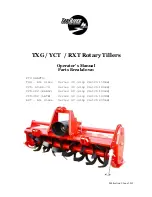
RTAA-SVX01A-EN
115
Periodic Maintenance
Perform all maintenance procedures and inspections at the recommended
intervals. This will prolong the life of the equipment and minimize the possi-
bility of costly failures.
Use an “Operator's Log”to record an operating history for the unit. The log
serves as a valuable diagnostic tool for service personnel. By observing
trends in operating conditions, an operator can anticipate and prevent
problem situations before they occur.
If the unit does not operate properly during maintenance inspections, refer to
“Diagnostics and Troubleshooting”.
Weekly Maintenance
After the unit has been operating for approximately 30 minutes and the
system has stabilized, check the operating conditions and complete the
procedures below:
•
Check the evaporator refrigerant pressure and the condenser refrigerant
pressure in the Refrigerant Report Menu on the Clear Language Display.
The pressures are referenced to sea level (14.6960 psia).
•
Check the liquid line sight glasses. The refrigerant flow past the sight
glasses should be clear. Bubbles in the refrigerant indicate either low
refrigerant charge, non condensable or excessive pressure drop in the liq-
uid line. A restriction in the line can sometimes be identified by a notice-
able temperature differential between the two sides of the restriction.
Frost may often form on the line at this point. Proper refrigerant charges
are shown on Table 1.
CAUTION
Equipment Check!
A clear sight glass alone does not mean that the system properly
charged. Also check system superheat, subcooling, and unit
operating pressures.
•
If operating pressures and sight glass conditions seem to indicate refrig-
erant shortage, measure the system superheat and system subcooling.
Refer to “System Superheat” and “System Subcooling”.
•
If operating conditions indicate a refrigerant overcharge, remove refriger-
ant at the liquid line service valve. Use appropriate refrigerant recovery
practices that allow refrigerant to escape slowly, to minimize oil loss. Do
not discharge refrigerant into the atmosphere.
•
Inspect the entire system for unusual conditions and inspect the con-
denser coils for dirt and debris. If the coils are dirty, refer to RTAA-SB-20
and RTAC-SVG01A-EN.
Monthly Maintenance
•
Perform all weekly maintenance procedures.
•
Measure and record the system superheat. Refer to “System Superheat”.
•
Measure and record the system subcooling. Refer to “System
Subcooling”.
Summary of Contents for RTAA-100
Page 110: ...110 RTAA SVX01A EN Start Up Procedures Figure 37 Unit Sequence of Operation...
Page 143: ...RTAA SVX01A EN 143 Pump Package Figure 47 Pump Package Piping Schematic...
Page 144: ...144 RTAA SVX01A EN Pump Package...
Page 146: ...146 RTAA SVX01A EN 3327...
Page 147: ...RTAA SVX01A EN 147...
Page 148: ...148 RTAA SVX01A EN 3328...
Page 149: ...RTAA SVX01A EN 149...
Page 150: ...150 RTAA SVX01A EN 6516...
Page 151: ...RTAA SVX01A EN 151...
Page 152: ...152 RTAA SVX01A EN 3329...
Page 153: ...RTAA SVX01A EN 153...
Page 154: ...154 RTAA SVX01A EN 6472...
Page 155: ...RTAA SVX01A EN 155...
Page 156: ...RTAA SVX01A EN 156 3330...
Page 157: ...157 RTAA SVX01A EN...
Page 158: ...158 RTAA SVX01A EN 6046...
Page 159: ...RTAA SVX01A EN 159...
Page 160: ...160 RTAA SVX01A EN 3331...
Page 161: ...RTAA SVX01A EN 161...
Page 162: ...162 RTAA SVX01A EN 6519...
Page 163: ...RTAA SVX01A EN 163...
Page 164: ...164 RTAA SVX01A EN 6047...
Page 165: ...RTAA SVX01A EN 165...
Page 166: ...166 RTAA SVX01A EN 3325...
Page 167: ...RTAA SVX01A EN 167...
Page 168: ...168 RTAA SVX01A EN 6048...
Page 169: ...RTAA SVX01A EN 169...
Page 172: ...172 RTAA SVX01A EN 3326...
Page 173: ...RTAA SVX01A EN 173...
Page 174: ...174 RTAA SVX01A EN 6049...
Page 175: ...RTAA SVX01A EN 175...
Page 176: ...176 RTAA SVX01A EN 6463...
Page 177: ......
















































